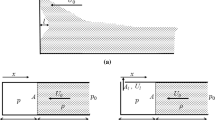Abstract
Sloshing phenomenon in the liquid cargo carriers has caught the attention of researchers as the interaction between the sloshing waves and structure is one of the key point and difficulty in the study of sloshing. In this paper, we captured the free surface with a volume of fluid (VOF) method and then calculated the motions and responses of the structure by adopting the Reynolds-averaged Navier-Stokes (RANS) equations for the whole fluid domain. With the use of user defined functions (UDF) in Fluent, the interaction between fluid and structure was then simulated. As a reasonable simplification, the authors studied the response of a single cantilever in a tank under sloshing loads; Further study should pay more attention to the mechanisms of interaction between sloshing waves and elastic structures.
Similar content being viewed by others
References
Amano, K, Koizumi, M. and Yamakawa, M (1990). Three-dimensional analysis of sloshing problems using a boundary element method. Trans (1st report). JSME, Part B, 56(523), 684–689.
Jin Xian-Ding (1987). Vibration in ships. Shanghai Jiao Tong University Press, Shanghai, 106–202 (in Chinese).
Li Qing(2004). Numerical Analysis of Fluid-Structure Interaction between Large Sloshing Viscous Fluid and Tank. Degree of Master of Engineering Thesis, Tsinghua University, Beijing. (in Chinese).
Liu Ze-Min(1993). A Finite Element Analysis. Doctor Dissertation, Harbin Engineering University, Harbin. (in Chinese).
Mateusz Graczyk, Moan, M., Wu, M(2007). Extreme sloshing and whipping-induced pressures and structural response in membrane LNG tanks. Ships and Offshore Structures. 2(2), 201–216.
Ramasway B, Kawahara M(1987). Lagrangian finite element analysis applied to viscous free surface fluid Flow. Int J Num Meth F1uid.
Shang Da-Zhong, Li Hong-liang, Han Guang-cai(2005). Dynamic analysis of structure. Harbin Engineering University Press, Harbin, 167–170. (in Chinese).
Tian Ye Shi Kai, Shan chuan zheng gang (1991). Boundary smooth method three-variable analysis. JSME Proceedings. B Editing, 57(540). (in Japanese).
Wang Fu-Jun (2004). Computational fluid dynamics analysis — CFD software principle and application. Tsinghua University Press, Beijing. (in Chinese).
Wang. M. and Troesch. A. W (1997). Numerical stability analysis for free surface flows. Int. J. Numer. Methods in Fluids, (24), 893–912.
Xie Zuo-Shui (2004). Computational structural mechanics. Huazhong University of Science and Technology Press, Wuhan, 172–177.
Zhang Zi-Ming, Du Cheng-Bin, Zhou Xing-de (2008). Structural dynamics. Tsinghua University Press, Beijing, 60–67. (in Chinese).
Zhang, A., Suzuki, K (2007). A comparative study of numerical simulations for fluid-structure interaction of liquid-filled tank during ship collision. Ocean Engineering, 34, 645–652.
Zhu Ren-Qing (2001). Time Domain Simulation of Liquid Sloshing and Its Interaction with Flexible Structure. Ph. D. Thesis, China Ship Scientific Research Center, Wuxi. (in Chinese).
Zhu Ren-Qing, Fang Zhi-Yong, Wu You-sheng (2006). Research on viscous liquid sloshing and its interaction with flexible structure based on Level-set method. 7th. ICHD’06, 4–6, Oct. in Naples, Italy.
Zhu Ren-Qing, Wu You-Sheng, Incecik Atilla (2004). Numerical simulation of liquid sloshing—A review. Shipbuilding of China, 45(2), 16–27.
Author information
Authors and Affiliations
Additional information
Foundation item: Supported by the National Natural Science Foundation of China under the Grant No.10472032, 50879030.
Ling HOU was born in 1985. She is a postgraduate at Jiangsu University of Science and works at Engineering college of Guangdong Ocean University now. Technology and Her current research interests include ship hydrodynamics.
Ren-Qing ZHU was born in 1965. He is a professor at Jiangsu University of Science and Technology. His current research interests include hydrodynamics and hydroelasticity, etc.
Rights and permissions
About this article
Cite this article
Hou, L., Zhu, Rq. & Wang, Q. The two-dimensional study of the interaction between liquid loshing and elastic structures. J. Marine. Sci. Appl. 9, 192–199 (2010). https://doi.org/10.1007/s11804-010-0002-0
Received:
Published:
Issue Date:
DOI: https://doi.org/10.1007/s11804-010-0002-0




